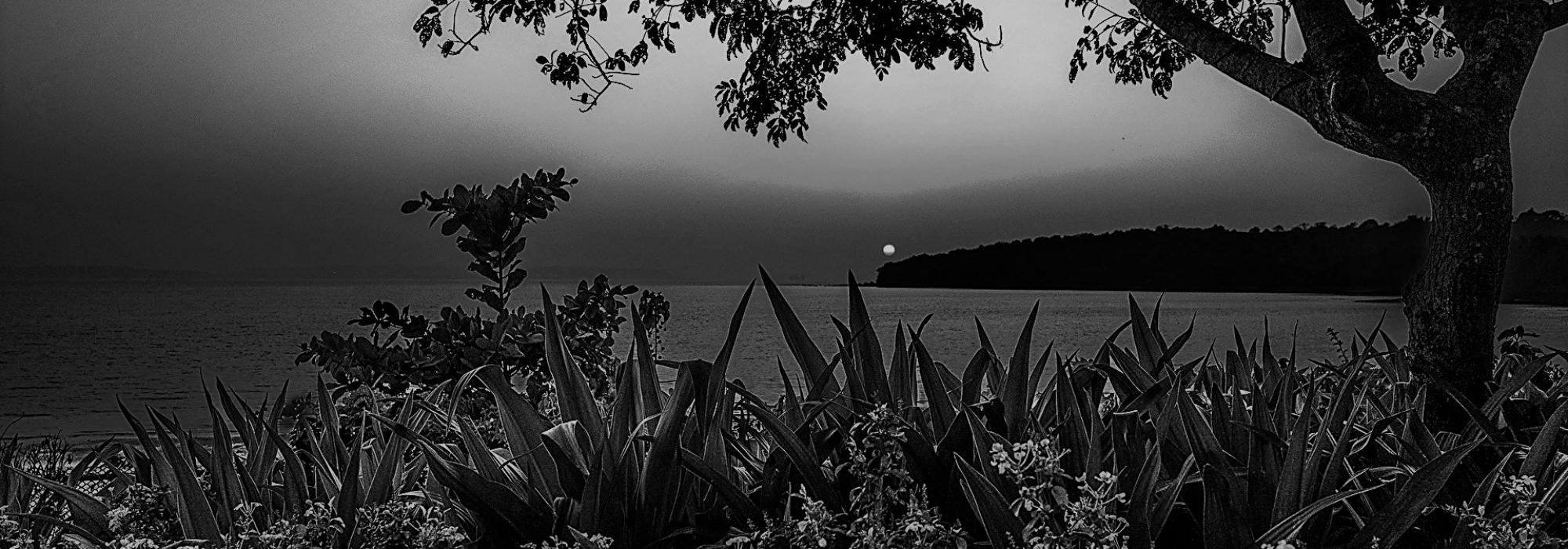“Crescent moon appears on Śiva’s neck”:
उमानर्मविलासोद्यन्नखरक्षतहेतुना।
ग्रीवायामर्धचन्द्रोऽसौ चन्द्रचूडस्य दृश्यते॥[1]
Caught in throes of love, Umā adorned her husband with her nail-mark. It appears like the crescent moon on Śiva’s neck.
The challenge has taken up two whole lines, necessitating the solution to be pithy. Fulfilling this requirement admirably, the poet has composed a single long compound as the solution. The beauty of the solution opens up to readers when they realise that Śiva’s neck was blue, the colour of the sky, against which the crescent moon appears vivid.
“A hundred moons appear in the sky”:
विधे पिधेहि शुभ्रांशुमद्यैकोऽपि सुदुस्सहः।
कुरु प्रियासमाश्लेषे शतचन्द्रं नभस्स्थलम्॥[2]
O Fate, conceal the moon for just this one night—he’s too unbearable. When I’m in the arms of my beloved, may a hundred moons adorn the sky.
The solution is based on the poetic convention that the moon causes unspeakable distress to lovers in separation.
“Rāma abandons his two wives and sports with a third”:
रामो भार्याद्वयं त्यक्त्वा तृतीयामेव सेवते।
लज्जा कीर्तिस्तथा सीता तिस्रो रामं हि वव्रिरे॥[3]
Sītā, Lajjā (modesty), and Kīrti (fame) were Rama’s wives. Forsaking his two wives, Rāma is engaged with the third alone.
The solution is based on the banishment of Sītā. However, the order in which the three wives are mentioned is faulty.
“A beautiful woman loved a hermit”:
परिव्राजकमात्मीयमकरोद्वरवर्णिनी।
सुभद्रा कृष्णभगिनी कुहनावेषधारिणम्॥[4]
Subhadrā, Kṛṣṇa’s sister, gave herself to Arjuna who’d come in the guise of a saint. And hence, a beautiful woman loved a hermit.
“Gaurī is uninterested to unite with her husband”:
आश्लेषे परिपन्थिनस्तु फणिनः कण्ठग्रहे दारदो
मौलौ नर्मपदप्रहारविभवे स्पर्धालुरिन्दुर्नवः।
लालाटानल आस्यचुम्बनविधौ वैरी रतोद्दीपने
गङ्गैव प्रतियोगिनीत्थमभवे गौरी न भोगोत्सुका॥[5]
I can’t embrace him; wily snakes repel it. I can’t put my arm round his neck; poison prevents me. I can’t playfully place my foot on his head; the moon competes with me. I can neither kiss him on the forehead nor develop steam in love making; fire forbids it. And then there is my arch-rival Gaṅgā! Thinking thus, Gaurī is uninterested to unite with her husband.
This is an ornate verse replete with many apt details. Composing such a verse extempore is rather difficult, since it expects a certain leisure and composure.
“Dawn broke during night”:
वसन्तशीतांशुपुरस्सरोऽसौ
प्रवर्तितः काममहो मनोज्ञः।
अबीरसेकात्परितः प्रजानां
राकानिशायामरुणोदयोऽभूत्॥[6]
When the moon rose on the day of Holi, people played around with crimson jets of water. Thus, it was dawn during night.
The usage of the rare word ‘abīra’ and the allusion to Holi speak volumes of the poet’s erudition and creativity.
“A proud young man doesn’t look at himself in the mirror”:
ऋजुतामानी नित्यं
भजते ननु चौक्षमेव सततं जगति।
विपरीतदर्शनतया
दर्पणविमुखो बभूव दर्पकयुवकः॥[7]
A self-righteous swears by puritanism. Scared of lateral inversion, such a proud young man doesn’t look at himself in the mirror!
This humorous verse takes a jibe at all puritans. That the poet has employed an idea related to inversion in mirror-images is a telling sign of his keen observational powers. The rare word used to denote obsessive purity (caukṣa) is noteworthy.
“Kā-khā-gā-ghā”:
ए-बी-सी-डी-विद्याभासे विद्याभ्यासे चास्मिन्देशे।
प्रायः स्वप्नेऽप्यासाद्यो नो देशीयोक्त्या काखागाघा॥[8]
In our country, education equates to learning the English alphabet—a-b-c-d-… In this state of affairs, it is nigh impossible to even dream of education in regional languages—ka-kha-ga-gha-…
This is an acerbic reflection on the state of affairs of modern Indian education.
“Gulu-guggulu-guggulu”:
बेङ्गलूरुपुरे नित्यं जलाभावाभिभाविते।
रवः कदापि नाले स्याद्गुलुगुग्गुलुगुग्गुलु॥[9]
In Bengaluru city that is afflicted by perpetual shortage of water, there’s a tiny chance of hearing the taps go gulu-guggulu-guggulu.
This challenge is found in Bhoja-prabandha. While the solution in that work presents a pleasant picture of nature, the present solution, as a contrast, is witty.
“Legless trees run around”:
‘मेक्बेथ्’नाम्नि ख्याते मनोहरे रूपके नु चरमाङ्के।
‘बर्नं’काननसंस्थाः पदरहिताः पादपास्तु धावन्ति॥[10]
In the last act of Macbeth, the wonderful play, in the form of Birnam forest,
legless tress run around.
This is a classic case of the solution being entirely based on erudition. The allusion to a Shakespearean play in a Sanskrit verse is novel. Being able to freely draw ideas from the wide lore of world literature is one of the advantages of a modern poet.
“Sun shines brightly during night”:
यात्रासु दीर्घविशदासु विमानयाने
स्मृत्वा स्वदेशसमयं किल भारतीयः।
वातायने च सुनिशम्य विचित्रमूचे
रात्रौ रराज रविरम्बरमध्यसंस्थः॥[11]
Bounded on a long journey in an airplane, an Indian couldn’t take off Indian Standard Time (IST) from his mind. Looking out of the window, he exclaimed, “Sun is shining bright during night!”
[1] Ibid., p. 289
[2] Pisupāṭi Cidambara-śāstri-gāri jīvita-caritra, avadhāna-sāhityam, p. 112
[3] Śatāvadhāna-surabhāratī-saurabham, p. 28
[4] Avadhāna-vidyā-sarvasvamu, p. 777
[5] Ibid., p. 290
[6] Ibid., p. 291
[7] Ibid., p. 292
[8] Ibid., p. 326
[9] Ibid.
[10] Ibid.
[11] Ibid., p. 331–32
To be continued.









































